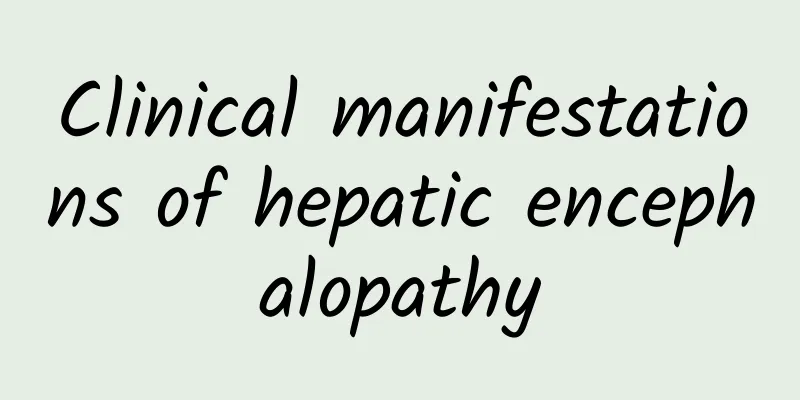Clinical manifestations of hepatic encephalopathy

|
Hepatic encephalopathy, also known as hepatic coma, is caused by functional failure of the patient's liver cells after cirrhosis. It is also a common complication of cirrhosis. It is very harmful to patients, and this disease is often irreversible. It often causes relatively serious harm to the patient's life safety. After suffering from hepatic encephalopathy, you must pay attention to conditioning and receive timely treatment. Eight symptoms of hepatic encephalopathy should be remembered 1. Onset It can be urgent or slow. Acute hepatic encephalopathy has an abrupt onset, and the prodromal period is extremely short. Patients may quickly fall into a coma, which often occurs after the onset of jaundice. Some patients may also have impaired consciousness before the onset of jaundice and be misdiagnosed as mental illness. Chronic hepatic encephalopathy has an insidious or gradual onset and is often difficult to detect at first, making it easy to misdiagnose or miss the diagnosis. 2. The appearance of liver odor It is a characteristic odor caused by liver failure, in which the intermediate products of sulfur-containing amino acid metabolism (such as methyl mercaptan, ethyl mercaptan and dimethyl sulfide) in the body are exhaled through the lungs or emitted through the skin. Some scholars call this smell rotten apple, garlic, fish, etc. 3. Changes in sleeping habits It often manifests as sleep inversion, also known as impending coma. Some people have found that this phenomenon is related to the disorder of the phase of serum melatonin secretion in patients, indicating that the excitement and inhibition of the patient's central nervous system are in a disordered state, which often indicates that hepatic encephalopathy is imminent. 4. Personality changes It is often the earliest symptom of the disease, mainly in people with extroverted personality who show depression, while introverted personality who show euphoria and polyglotism. 5. Behavioral changes Initially, it may be limited to some "careless" behaviors, such as scribbling, splashing water, spitting, throwing paper scraps and cigarette butts, touching and searching everywhere, urinating and defecating anywhere, dragging and placing tables and chairs in the room at random, and other meaningless actions. 6. Asterixis It is the most characteristic neurological sign of hepatic encephalopathy and has early diagnostic significance. Unfortunately, not all patients experience asterixis. The method is: ask the patient to stretch out his forearm, spread out his five fingers, or overextend his wrist and keep it still. The patient's palm-to-finger and wrist joints may experience rapid flexion and extension movements, which may occur 1 to 2 times per second, and may reach 5 to 9 times per second, and are often accompanied by lateral movements of the fingers. At this time, the patient may also have subtle tremors of the entire upper limbs, tongue, jaw, and gait ataxia. It may occur on one side or on both sides. This tremor is not characteristic and can also be seen in patients with heart failure, renal failure, lung failure, etc. Tremors often disappear when the patient is asleep or in a coma, but may still occur after waking up. 7. Intellectual Disability As the disease progresses, the patient's intelligence changes, manifested as unclear concepts of time and space, blurred concepts of people, unclear enunciation, incoherent speech, difficulty writing, decreased calculation and counting abilities, and errors in connecting numbers. It is also a simple and reliable method for early identification of hepatic encephalopathy. 8. Visual impairment Uncommon. However, in recent years, there have been increasing reports in domestic and foreign literature that when hepatic encephalopathy occurs, patients may experience visual impairment and blindness as the main clinical manifestations. This visual impairment is transient and functional, and may worsen as hepatic encephalopathy progresses, and may also recover as hepatic encephalopathy recovers. Its pathogenesis is unclear, and most people believe that it is as complex as hepatic encephalopathy and is the result of the combined action of multiple factors. |
<<: What is cerebral infarction?
>>: Dietary care for hepatic encephalopathy
Recommend
Some home-cooked dishes for colds
When you have a cold, you often have a poor appet...
How long does it take to survive small cell lung cancer?
Small cell lung cancer is also a small part of lu...
Symptoms and best treatment for pharyngitis, dietary remedies for pharyngitis
Pharyngitis is an inflammation of the throat caus...
The efficacy and function of thistle
Thistle, also known as horse thistle, is a very s...
What is liver cyst?
Liver cyst is a common benign disease, which main...
Is pituitary tumor treatable?
The reason why people are afraid of getting tumor...
What are gout stones and what are the common symptoms?
Gout stones are a disease that causes great harm ...
What is the fastest way to pass gas after a cesarean section?
Everyone knows that a woman's body will chang...
Side effects of hyperthyroidism medication
Hyperthyroidism, also known as overactive thyroid...
What is the cause of pain in the lower abdomen?
There are many reasons for abdominal pain, coveri...
Left eye socket pain causes left side headache
The characteristic of left eye socket pain leadin...
What are the symptoms of accidental miscarriage?
For pregnant women, if they do not take proper ca...
Thyroid disease
Diseases are very harmful to human health. Differ...
Chinese medicine Astragalus pictures
Scutellaria baicalensis is a commonly used Chines...
Is ceftriaxone effective for otitis media?
I believe that otitis media is not unfamiliar to p...









